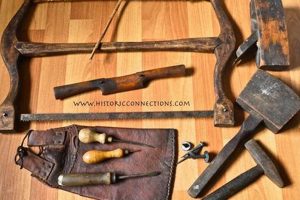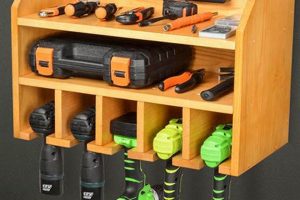These implements represent a specific brand of equipment employed in the shaping and fabrication of wood. They are utilized in both professional and hobbyist settings for tasks ranging from basic cuts to complex joinery. An example would be a table saw or lathe produced under this particular manufacturer’s name.
The significance of these instruments lies in their contribution to precision and efficiency within the woodworking process. Benefits often include enhanced accuracy, reduced material waste, and increased production speed. The company’s history often reflects a commitment to quality and innovation in the design and manufacture of woodworking machinery.
The subsequent sections will delve into specific aspects of this brands offerings, exploring various machine types, performance characteristics, and factors to consider when selecting appropriate equipment for specific woodworking applications.
Expert Guidance for Woodworking Excellence
The following recommendations are designed to optimize the utilization of woodworking equipment, enhancing project outcomes and extending the lifespan of machinery.
Tip 1: Implement Consistent Maintenance Schedules: Regular cleaning, lubrication, and inspection are crucial. Accumulated dust can impair performance, while inadequate lubrication leads to increased wear and tear. Consult the manufacturer’s guidelines for specific maintenance requirements.
Tip 2: Prioritize Blade and Bit Selection: Matching the cutting tool to the material is essential for achieving clean cuts and minimizing strain on the equipment. Employ high-quality blades and bits designed for the specific wood type and operation.
Tip 3: Ensure Proper Dust Collection: Effective dust collection systems contribute to a safer working environment and prevent the accumulation of debris within the machinery. Invest in a system with adequate airflow and filtration capacity.
Tip 4: Adhere to Recommended Operating Speeds: Operating equipment at excessive speeds can compromise accuracy and increase the risk of damage. Refer to the equipment manual for optimal speed settings for different tasks and materials.
Tip 5: Verify Accurate Calibration: Regularly check and adjust the calibration of all components, including fences, scales, and lasers. Accurate calibration is paramount for achieving precise cuts and consistent results.
Tip 6: Invest in Appropriate Safety Gear: Protective eyewear, hearing protection, and dust masks are indispensable. Prioritize safety to prevent injuries and maintain a healthy working environment.
Tip 7: Utilize Proper Stock Support: When working with long or heavy pieces, provide adequate support to prevent bowing or misalignment. Outfeed tables and roller stands can significantly improve stability and accuracy.
These guidelines promote efficient operation, minimize equipment downtime, and contribute to consistently high-quality woodworking results.
The subsequent section will summarize the key considerations when selecting suitable equipment and provide an overview of common woodworking applications.
1. Precision Engineering and Harvey Woodworking Tools
Precision engineering is a cornerstone of the design and manufacturing philosophy associated with equipment produced under this brand name. This commitment manifests in tight tolerances, meticulously calibrated components, and stringent quality control processes. The effect of this focus on precision is evident in the accuracy and repeatability of cuts and operations performed using this equipment. A real-life example is the precise alignment of the table saw blade relative to the fence, ensuring consistent rip cuts without deviation.
The importance of precision engineering extends beyond mere accuracy; it also influences the lifespan and reliability of the tools. Reduced vibration, smoother operation, and minimized wear and tear are direct consequences of high-precision manufacturing. This, in turn, translates to lower maintenance costs and increased productivity. For example, a precisely balanced lathe spindle minimizes vibration, resulting in smoother turning operations and longer bearing life.
In summary, precision engineering is an integral component, and critical for high-quality woodworking. This translates to tangible benefits for the user, including improved accuracy, enhanced efficiency, and extended tool lifespan. While achieving and maintaining this level of precision may present manufacturing challenges, it is essential for delivering equipment that meets the demands of professional and serious hobbyist woodworkers.
2. Material Quality
Material quality represents a foundational element in the construction and performance of equipment produced under this brand. The specific materials chosen directly impact durability, precision, and operational lifespan. This focus extends beyond individual components to encompass the entire structural integrity of each machine.
- Cast Iron Components
The utilization of high-grade cast iron in critical components, such as tables, bases, and frames, provides exceptional vibration dampening and structural rigidity. This is crucial for maintaining accuracy during demanding operations. For example, a cast iron table on a table saw ensures a stable, flat surface, minimizing deflection and contributing to precise cuts. The weight and density inherent in cast iron also reduce movement and vibration, leading to smoother operation and improved operator control.
- Steel Alloys and Fasteners
The selection of appropriate steel alloys for shafts, spindles, and fasteners is essential for withstanding high stresses and resisting wear. The use of hardened steel in key components, like lathe spindles, minimizes deflection under load and extends service life. Similarly, high-strength fasteners, often treated to resist corrosion, ensure secure connections and prevent loosening over time, contributing to overall structural integrity.
- Motor Materials and Windings
The quality of materials used in the motors powering this machinery directly impacts performance and reliability. Copper windings, known for their superior conductivity, are often employed to maximize motor efficiency and reduce heat generation. High-quality bearings minimize friction and ensure smooth operation. The choice of motor casing materials, typically cast iron or steel, provides protection from physical damage and environmental factors.
- Blade and Cutter Materials
The blades and cutters, arguably the most critical elements in the woodworking process, are crafted from specialized materials designed for specific applications. High-speed steel (HSS) and carbide-tipped blades offer varying degrees of hardness, wear resistance, and cutting performance. The choice of blade material depends on the type of wood being worked, the desired finish, and the expected lifespan of the cutting tool. Proper material selection is fundamental for achieving clean, efficient cuts and maximizing blade longevity.
The commitment to high-quality materials is consistently demonstrated across the product line, from the entry-level models to the professional-grade machines. These materials provide a foundation for reliable operation, longevity, and precision. It results in equipment that not only performs well but also stands the test of time, delivering value for years to come.
3. Performance consistency
Performance consistency is a critical attribute directly affecting the reliability and predictability of equipment from this manufacturer. It implies that the machine will operate within specified parameters across various applications and over extended periods, delivering similar results under identical conditions. This predictability is crucial for professional woodworkers and serious hobbyists who require consistent output for projects involving multiple pieces or repetitive tasks. For instance, a jointer is expected to produce consistently square edges, regardless of the number of boards processed or the duration of the operation. Any deviation from this consistent performance introduces errors, increasing waste and diminishing overall project quality.
One practical example of performance consistency is found in the repeatable accuracy of a table saw’s fence system. If the fence consistently deviates from the set measurement, even by a small fraction of an inch, the cumulative effect can be significant, leading to misaligned joints and dimensional inaccuracies in the finished product. Similarly, a lathe with inconsistent spindle speed or excessive vibration will produce uneven turnings, requiring additional sanding and potentially compromising the structural integrity of the piece. The manufacturer’s commitment to precision engineering and high-quality materials directly contributes to this desired consistency. Well-designed machines, built with robust components, are less susceptible to wear and tear, maintaining their performance characteristics over time.
Maintaining performance consistency necessitates regular maintenance and calibration. Even the best-engineered equipment can experience performance degradation due to dust accumulation, component wear, or improper adjustments. Adhering to the manufacturer’s recommended maintenance schedule, including lubrication, cleaning, and periodic calibration checks, is crucial for preserving the equipment’s original performance characteristics. In conclusion, performance consistency is not merely a desirable feature but an essential requirement for serious woodworking, enabling repeatable results, minimizing waste, and enhancing the overall quality of finished projects. It is a direct result of quality materials and careful manufacturing processes.
4. Safety features
Safety features form an integral component of woodworking equipment. Their incorporation directly affects operator well-being and mitigates the risk of injury during operation. In the context of the specified equipment, safety mechanisms are not merely add-ons, but rather, inherent design elements integrated to enhance user protection. A primary example is the blade guard on a table saw, designed to prevent accidental contact with the spinning blade. Similarly, emergency stop buttons allow for immediate machine shutdown in hazardous situations. These features, when properly utilized, significantly reduce the potential for accidents in the workshop.
The effectiveness of safety features depends on both their design and the operator’s adherence to safety protocols. A well-designed dust collection system, for example, minimizes the inhalation of airborne particles, reducing the risk of respiratory problems. Interlock switches, which prevent machine startup when safety guards are not in place, serve as a critical safeguard against operator error. The practical application of these safety mechanisms requires thorough operator training and a commitment to safe work practices. Ignoring safety protocols, even with advanced safety features in place, can negate their intended benefits. Furthermore, the selection of appropriate personal protective equipment, such as eye and ear protection, is crucial for minimizing injury risk.
In conclusion, safety features are a paramount consideration in woodworking. They provide a necessary layer of protection for operators, contributing to a safer and more productive work environment. Their effectiveness hinges on proper design, operator training, and consistent adherence to established safety protocols. Neglecting these aspects can significantly increase the risk of accidents, even with the most advanced safety mechanisms in place. Understanding the practical implications of each safety feature and its proper utilization is essential for responsible woodworking.
5. Durability
Durability, in the context of equipment from this manufacturer, signifies the ability to withstand prolonged use and environmental stressors without experiencing significant degradation in performance or structural integrity. This characteristic is directly linked to the quality of materials employed, the precision of manufacturing processes, and the robustness of the overall design. The cause-and-effect relationship is clear: higher-quality materials and more rigorous manufacturing standards translate to increased durability. The importance of durability as a component cannot be overstated; it directly impacts the return on investment, reducing the frequency of repairs and replacements, and minimizing downtime. A real-life example involves a woodworker using a table saw daily for several years. A durable saw, built with a heavy-duty motor and a sturdy cast iron frame, will maintain its accuracy and power output over time, while a less durable saw may experience motor failure, warped components, or decreased cutting precision. Understanding the factors contributing to durability allows informed purchase decisions, prioritizing long-term value over initial cost savings.
The practical significance of durability extends beyond simply avoiding breakdowns. A durable machine holds its value better, making it a more attractive investment. Furthermore, a durable tool inspires confidence in its user. The knowledge that the equipment can withstand demanding tasks allows the operator to focus on the craft, rather than worrying about potential mechanical failures. This enhanced confidence translates to improved accuracy, efficiency, and overall productivity. For example, a robust lathe, capable of handling large and unbalanced workpieces without excessive vibration, allows the woodturner to execute complex designs with greater precision and control. The initial investment in a durable lathe might be higher, but the long-term benefits, in terms of reduced maintenance costs, increased productivity, and improved quality of finished products, often justify the expenditure.
In summary, durability is a key attribute, directly linked to materials, manufacturing, and design. Its presence ensures longevity, reduced maintenance, and a heightened sense of operator confidence. While initial costs may be higher, the long-term value and reliability associated with durable equipment make it a strategically sound investment for serious woodworkers. Challenges remain in accurately assessing the long-term durability of equipment before purchase, necessitating careful research, consultation with experienced users, and a thorough understanding of the manufacturer’s reputation for quality.
6. Innovation
Innovation serves as a driving force behind the evolution of equipment produced under this brand. The incorporation of novel technologies and design principles directly affects performance, efficiency, and safety. A tangible example is the development of advanced dust collection systems integrated directly into the machines, mitigating airborne particulate matter and improving the work environment. Similarly, the implementation of digital control systems, enabling precise adjustments and repeatable operations, exemplifies the application of innovation to enhance user experience and project outcomes. These advancements are not merely cosmetic alterations; they represent substantive improvements that address real-world challenges faced by woodworkers. The cause-and-effect relationship is evident: the pursuit of innovation leads to the creation of tools that are more accurate, efficient, and user-friendly. The importance of innovation as a component is crucial, ensuring equipment remains competitive and meets the evolving needs of the woodworking community. It differentiates the products from competitors and drives progress within the industry.
The practical significance of innovation lies in its capacity to enhance productivity and reduce operational costs. For example, a saw featuring an innovative blade tensioning system can maintain consistent cutting performance over extended periods, minimizing the need for adjustments and blade replacements. Similarly, a lathe incorporating an advanced variable-speed control allows the operator to optimize cutting parameters for different materials and turning techniques, maximizing material yield and reducing the risk of errors. The adoption of these innovative features translates to tangible benefits for both professional and hobbyist woodworkers, enhancing their ability to produce high-quality work efficiently. The focus on innovation has also driven the development of new materials and manufacturing processes, resulting in equipment that is both more durable and more environmentally friendly.
In summary, innovation is an indispensable element, driving continuous improvement and enabling performance gains. Its integration into the design and functionality has a direct impact on the quality, efficiency, and safety of the equipment. While challenges exist in predicting which innovations will prove most valuable over time, the pursuit of novel solutions remains fundamental. This commitment to innovation ensures equipment remains at the forefront of the woodworking industry, delivering tangible benefits and enabling woodworkers to achieve their creative goals.
Frequently Asked Questions
The following addresses common inquiries regarding this brand’s equipment, providing factual information to assist in informed decision-making.
Question 1: What is the expected lifespan of equipment from this manufacturer?
The lifespan is contingent upon usage frequency, maintenance adherence, and operational conditions. However, due to the use of high-quality materials and robust construction, the equipment is generally expected to provide reliable service for many years with proper care.
Question 2: Where can replacement parts be obtained?
Replacement parts are typically available through authorized dealers and distributors. Direct contact with the manufacturer may also be necessary for specific or older models.
Question 3: What is the warranty coverage on equipment?
Warranty coverage varies by product and region. The specific terms and conditions are outlined in the warranty documentation provided with the equipment. It is essential to review this documentation upon purchase.
Question 4: Are training resources available for operating the equipment?
Training resources may include manuals, online tutorials, and in-person workshops offered by authorized dealers. The availability of these resources varies by product and location.
Question 5: What are the recommended maintenance procedures?
Recommended maintenance procedures typically include regular cleaning, lubrication, and inspection. Specific procedures are detailed in the equipment’s operating manual. Adherence to these procedures is crucial for maintaining optimal performance and prolonging the equipment’s lifespan.
Question 6: How does the equipment compare to competitors in terms of features and performance?
Equipment stands out with quality and performance. Specific comparisons necessitate detailed analysis of individual models, considering factors such as power, precision, and included features.
These answers provide general guidance regarding the equipment. Consulting specific product documentation and seeking advice from authorized dealers are recommended for detailed information.
The next section will explore case studies demonstrating the practical application of woodworking equipment in diverse project settings.
Conclusion
This exploration has detailed critical aspects of equipment bearing this name, encompassing engineering, material quality, performance consistency, safety features, durability, and innovation. Each of these components influences the overall utility and longevity of equipment in diverse woodworking applications. The equipment in question has been noted as a strong option, but requires careful assessment and consideration of all aspects before a final decision.
The aforementioned elements determine the equipment’s capacity to deliver precise, reliable, and safe performance. Independent research and evaluation is paramount in making an informed choice, ensuring the selected tools align with specific project requirements and operational standards.







